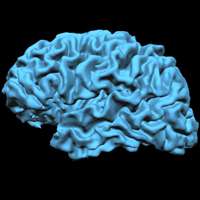MRI brain scan
When an animal encounters a new environment, the neurons in its brain that are responsible for mapping out the space are ready for anything. So says a new study in which scientists at the Howard Hughes Medical Institute's Janelia Research Campus examined neuronal activity in rats as they explored an unusually large maze for the first time.
The researchers found that neurons in the brain's hippocampus, where information about people, places, and events is stored, each contribute to an animal's mental map at their own rate. Some neurons begin to associate themselves with the new space immediately, while others hold back, contributing only if the space expands beyond a size that can be represented by the first-line neurons. Similar mechanisms may be at play as the human brain records a new experience, says Janelia group leader Albert Lee, who led the study. Lee, graduate student Dylan Rich, and Hua Peng-Liaw, a technician in Lee's lab, published their findings in the August 15, 2014, issue of the journal Science.
"The hippocampus has to represent arbitrary things," Lee says. "When a new experience begins, we don't know how long it's going to last, and the brain has to form a new representation on the fly. This mechanism means that the hippocampus doesn't have to adjust its representation if an environment is larger than predicted, or if an experience goes on longer than expected."
As an animal explores a new environment, cells in its hippocampus fire to mark new places that it encounters. The cells, called place cells, fire randomly, but become associated with the shapes, smells, and other sensory cues present in that location. In humans, analogous cells store memories of people, places, facts, and events.
In rodents, about a third of the cells in the region of the hippocampus devoted to spatial learning participate in mapping a typical laboratory-sized maze. Different mazes are represented by different but overlapping sets of neurons. The differences between those sets allow the brain to distinguish between memories of different environments.
But what happens when an animal finds itself in an environment larger than a five-meter laboratory maze? In the wild, rats can traverse territories as long as 50 meters. Lee wanted to know how the hippocampus kept track of environments that placed greater demands on its neurons.
If cells continued to mark off space at the rate that scientists had observed in more confined environments, the animal's mental map would quickly lose its uniqueness. "If every cell is active in the representation of a single space, then you can't use this mechanism to distinguish memories of different things," Lee points out.
So Lee and his team stocked up on supplies from the hardware store and built their own maze, far larger than any that had been used previously to track place cell activity. The 48-meter maze wouldn't fit inside Lee's lab, so Lee, Rich, and Liaw set it up in a large cage-cleaning room at Janelia.
The room was busy during the week, so the team did their experiments on weekends. For multiple weekends over the course of about two years, Janelia's vivarium staff would clear the room for them, and then the team would reassemble the maze and set up video cameras and electrophysiology equipment. The team recorded the activity of individual cells in the hippocampus as rats explored the maze for the first time. They first introduced the animals to a small portion of the maze, then gradually increased the territory to which the rats had access, monitoring how the brain added new information to its spatial map.
When the scientists analyzed their data, they discovered that from the time the rats entered the maze, their brains were ready to represent an environment of any size. "Instead of the hippocampus having to adjust in time as the animal notices that the maze gets larger, it anticipates all different sizes of mazes from the beginning," Lee says. "It does this by dividing up its population of neurons so that certain ones are ready to represent smaller mazes, others are ready to represent medium-size mazes, and others, large ones."
All of the neurons acted independently, firing randomly to mark off places in the maze. But some neurons had a greater propensity to mark off space than others, Lee explains. Some neurons mark space quickly and become associated with many places in the maze, whereas others are less likely to fire. These, Lee says, are reserved for mapping larger spaces.
In small environments, a subset of the cells that are most likely to mark off space – those that have a chance to fire while the animal explores – form the map on their own. In larger mazes, all of the neurons with a high propensity to mark space are recruited to the mapping effort, meaning they cannot be used to distinguish the representation of one large maze from another. That's when the neurons with a lower tendency to fire step in, randomly marking space in a distinct, identifying set.
"There's always a set of neurons that is just at the edge, where they are equally likely to represent any given environment versus not, regardless of what its size is," Lee says. "Those are the neurons the brain can actually use to distinguish which environment its in."
The system means the brain never has to adjust its representation of an environment as it is being created, Lee says. "All neurons are marking space at their own preferred rate, so there doesn't have to be a mechanism to say, 'you should fire because this maze is large or this maze is small.' The hippocampus is ready for anything at any moment."
Cells in the human brain may record events in a similar way, marking off time as an event unfolds without knowing how long it will continue, Lee says.
Journal information: Science
Provided by Howard Hughes Medical Institute






















